 |
| Our first view of Usaburo Kokeshi. |
Our very first kokeshi adventure took place on January 15th, 2011 when, on a whim, we got on the highway and headed due north of our home to Gunma Prefecture in central Honshu. We had a coupon for a kokeshi factory of some sort -- Usaburo Kokeshi (卯三郎こけし) -- located in Shibukawa City (渋川市), and it said that kids could make their own kokeshis. Why not go there we thought? After meandering around on the side of what must have once been a volcano we finally found the place, and what a nice surprise it turned out to be! Let's just say that anyone who like kokeshis will love this place.
 |
| Variety of kokeshis for sale. |
 |
| The essence of cuteness? |
 |
| Every one of the kokeshis here is a Christmas kokeshi. |
As I've explained in previous posts there are two different types of kokeshis: Traditional kokeshis, which come from northeastern Japan, and modern kokeshis which can come from anywhere in Japan, but are especially strong in Gunma Prefecture. Usaburo Kokeshi makes modern kokeshis of all types, from miniature ball-shaped ones, to the usual girl kokeshis, wedding kokeshis, and even creative sculptures where faces appear wood-nymph like out of small logs. One thing I can say with certainty is that Usaburo is especially adept at making kokeshis that are, well, cute. After seeing the amazing variety of kokeshis in the large retail area I was really struck by what can be done with just a small piece of wood.
 |
| More kokeshis. |
 |
| Painting kokeshis. |
 |
| The wood-working building. |
 |
| Working on a lathe. |
It quickly becomes clear that Usaburo Kokeshi is a full-scale factory rather than an artisan's shop. There are plenty of employees both in the wood-working area and paint shop, and they are making many of the same kokeshi as can be seen in the photos. The painters, who also make patterns and designs on the wood using using a burning device, are located inside the retail area and it is easy to watch them work. The wood shop is next door and is fully accessible to visitors. We walked through the shop and observed craftspeople at work on their lathes, and then through the main factory area where there were bins full of various unpainted kokeshi parts and piles of lumber waiting to become kokeshi parts. For those who enjoy seeing how things are made, such as I do, this was a treat. To be honest I am simply in awe of this kind of Japanese creativity. The people in this country have an inventiveness and eye for design that seems infinitely more advanced than that of the U.S. Also important is Usaburo and the other kokeshi makers actually make their kokeshis -- no outsourcing to China or some other third world country whose laborers do not understand what they are making. That in itself is of great value.
 |
| In the factory. |
There is also a free museum on the second floor of the main building, which is an ode to the Usaburo Kokeshi tradition. The
 |
| Industrial kokeshi making. |
beginnings appear to have been humble, as the company made small, fun commemorative wooden figures during the 1950s and 1960s that evolved into today's modern kokeshis. Unfortunately there is a no-photography policy in the museum or I would show some photos, but suffice it say that it was worth the visit. On a side note, Naoko and I saw two of our kokeshis in the museum, which means that we own museum pieces! More on our musuem kokeshis in a future post.
If you like modern kokeshis, then Usaburo Kokeshi is a must visit, and there are many reasonably priced pieces available, as well as more expensive and special ones too. Here is a link to the
English-language web site if interested. To sweeten the deal there is a wonderful onsen (hot bath) called Ikaho Onsen (伊香保温泉) right up the hill from Usabaro Kokeshi, which we spent an hour in after our taxing but delightful day at the kokeshi factory. Lucky us since it was snowing that evening. The only thing that was a disappointment was that Ikaho did not sell special kokeshis. After all, the Japanese kokeshi tradition likely started as souvenirs for sale at onsens in northeastern Japan.
 |
| Kokeshis being born. |
 |
| Making kokeshi parts. |
Overall, this was not just another successful kokeshi adventure. It was
the adventure that got us started on our quest to visit Japan's kokeshi makers, and learn as much as we can about this wonderful Japanese tradition.
 |
| These works of art are creative kokeshis. The one on the right was 40,000 yen. |
 |
| More creative kokeshis. |
 |
| Daruma kokeshis. |
 |
| Celebration kokeshis -- Add a message and give as a present. |
 |
| These pieces of wood will become kokeshis. |
 |
| Kokeshi bodies. |
 |
| It's amazing what can be done with a small piece of wood. |
 |
| Male and female bunny kokeshis. |
 |
| Wedding kokeshis. |
 |
| Baskets of mini kokeshis. |
 |
| Usaburo also sells spoons. |
 |
| Here is where you can paint your own kokeshi. |
 |
| Giant kokeshi outside the main building. |


















































